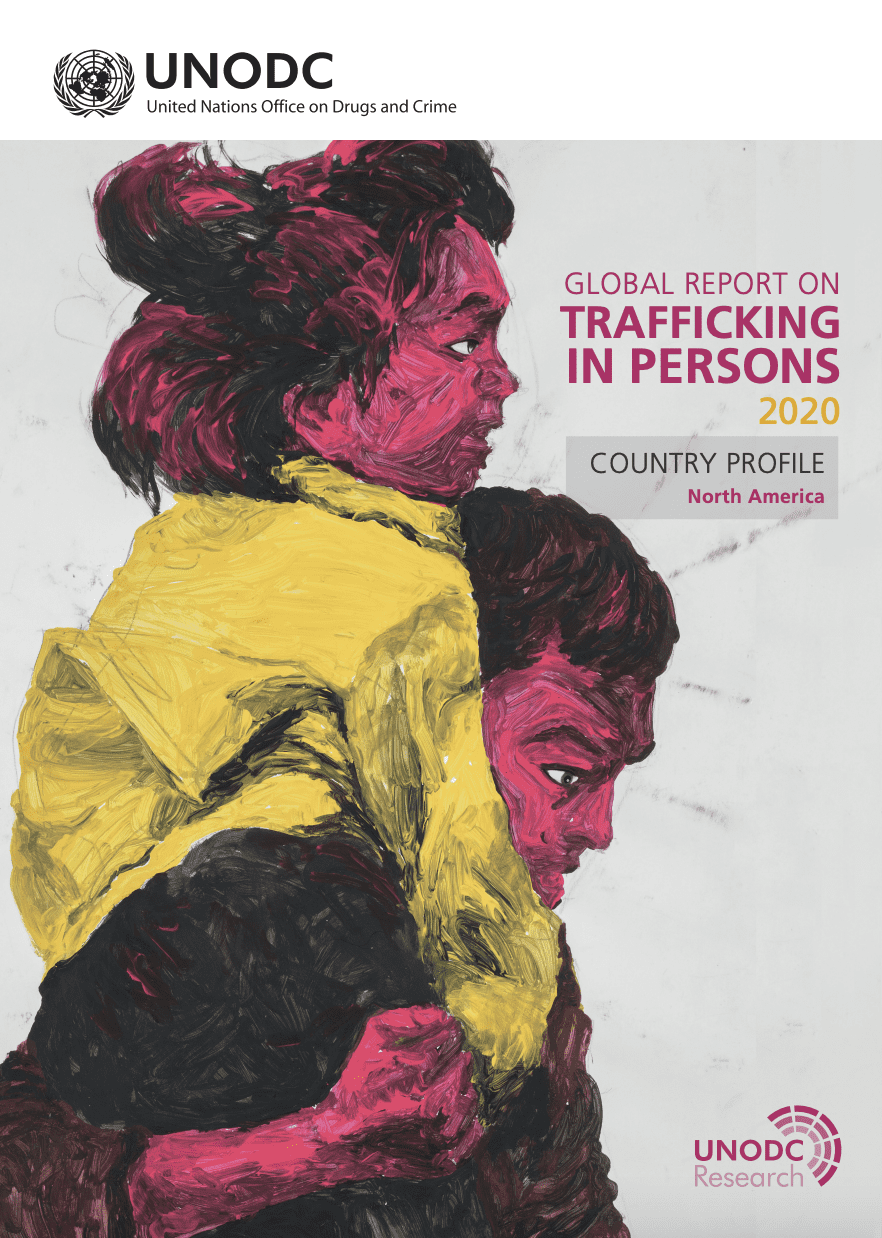
Global Report on Trafficking in Persons, Country Profile: North America
− Canada −
The current legislation on trafficking in persons in Canada covers all forms of trafficking indicated in the UN Trafficking in Persons Protocol.
Investigations and suspects
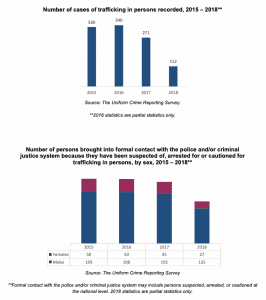

The Royal Canadian Mounted Police – Human Trafficking National Coordination Centre did not report on the citizenships of persons convicted of trafficking for 2017 and 2018. Prior to 2017, authorities reported that the majority convicted were Canadian nationals.
Source: The Royal Canadian Mounted Police – Human Trafficking National Coordination Centre.
Victims
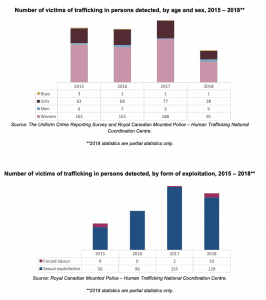
The Royal Canadian Mounted Police – Human Trafficking National Coordination Centre did not report on the citizenships of victims of trafficking in persons detected for 2017 and 2018. Between 2014 and 2017, authorities reported that the majority of detected victims were Canadian nationals with small numbers of persons originating from Asia, Central America, and the Caribbean. In 2017, Canadian authorities reported 157 Canadian national victims trafficked domestically, and in 2018 reported 139.
Source: Royal Canadian Mounted Police – Human Trafficking Coordination Centre.
− Mexico −
The current legislation on trafficking in persons in Mexico covers all forms of trafficking indicated in the UN Trafficking in Persons Protocol.
Investigations and suspects
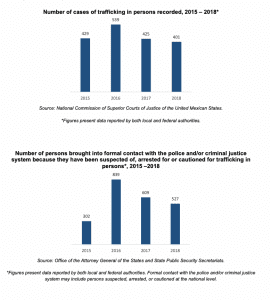
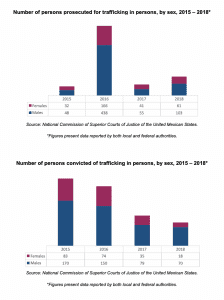
The majority of persons convicted of trafficking in persons in 2017 and 2018 were Mexican nationals. A smaller number were persons whose citizenship was unknown. Between 2014 and 2017, the majority of persons convicted were also Mexican nationals, with smaller shares of convicted persons from Central American countries.
Source: National Commission of Superior Courts of Justice of the United Mexican States.
Victims
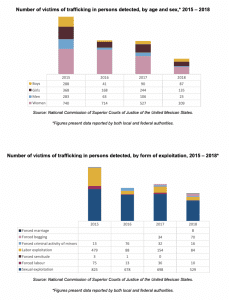
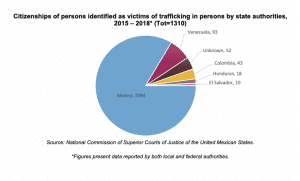
In addition, authorities identified eight victims from other South American countries, eight from other Central American countries, six from the Caribbean, three from Eastern Europe, and one from another North American country.
Source: National Commission of Superior Courts of Justice of the United Mexican States.
− United States of America −
The current legislation on trafficking in persons in the United States of America covers sex trafficking and forced labour.
Investigations and suspects
The Departments of Justice (DOJ), Homeland Security (DHS), and State (DOS) are the primary investigating agencies for federal trafficking offenses. While the Federal Bureau of Investigation (FBI) collects data on state and local human trafficking investigations, not all jurisdictions participate. In 2018, participating state and local jurisdictions reported a total of 548 human trafficking offences resulting in arrest or solved for crime reporting purposes, 545 in 2017, and 654 in 2016. There is no other formal mechanism to track prosecutions at the state and local levels.
Source: The U.S. Department of State Trafficking in Persons Report, 2018, 2019

The Department of Defense (DoD) investigates trafficking in persons cases involving U.S. military, DoD civilians, and Defense contractor personnel. In 2018, DoD reported 119 human trafficking cases involving DoD personnel.
The Department of Labor – Office of the Inspector General (DOL-OIG) investigates trafficking in persons cases involving fraud and abuse related to DOL’s programs, including Foreign Labor Certification programs. In FY 2017 and FY 2018, DOL-OIG opened four investigations both years related to labor trafficking allegations.
Source: Department of Labor Office for the Inspector General

The number of persons prosecuted for trafficking in persons does not correlate to the number of cases prosecuted as there may have been multiple defendants in a case. In 2016, DOJ brought 241 prosecutions, 282 in 2017, and 230 in 2018.
Source: The U.S. Department of State Trafficking in Persons Report, 2018, 2019.
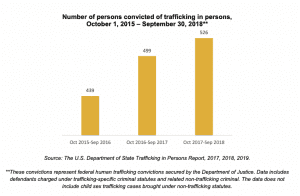
Victims
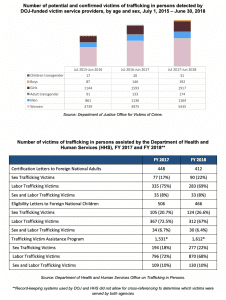
The Department of Health and Human Services (HHS) issued Certification and Eligibility Letters denoting the eligibility of foreign national victims for services and benefits to the same extent as refugees, provided grant funding for comprehensive case management for foreign national and domestic trafficking victims, and funded capacity-building grants for community-based organizations and child welfare systems to respond to trafficking. In FY 2017, HHS issued 954 Certification and Eligibility Letters and 878 in FY 2018. In FY 2018, 1,612 foreign national victims of trafficking and qualified family members and 1,149 domestic victims of trafficking received case management service through HHS’ grant-funded anti-trafficking programs.
DOJ provided funding to develop, expand, or strengthen victim service programs for domestic and foreign national victims of trafficking. In FY 2018, DOJ provided $31.2 million for 45 victim service providers who offer comprehensive and specialized services across the United States, a significant increase from $16.2 million in FY 2017. DOJ also provided $1.2 million in new funding to increase the availability of trauma-informed services and address barriers to assisting labor trafficking victims.
Source: Department of Justice Office for Victims of Crime and the Department of Health and Human Services.
The United States provides trafficking-specific immigration options through Continued Presence, which is a temporary immigration designation, and T nonimmigrant status, which is also a temporary immigration benefit. Those with T nonimmigrant status may be eligible to apply for lawful permanent resident status and eventually may be eligible for citizenship. T nonimmigrant status is available for victims of trafficking and eligible family members. In FY 2017, 1,336 victims and eligible family members were approved for T nonimmigrant status (672 victims and 690 eligible family members). In FY 2018, 1,278 were approved (580 victims and 698 eligible family members).
Source: United States Citizenship and Immigration Services and the U.S. Department of State Trafficking in Persons Report 2019

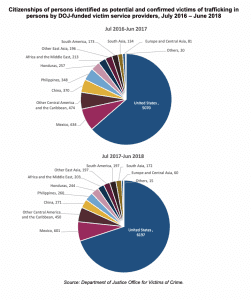
Trafficking victims originate from almost every region of the world. The top three countries of origin of federally identified victims in FY 2018 were the United States, Mexico, and the Philippines compared to the United States, Mexico, and Honduras in FY 2017.
Source: The U.S. Department of State Trafficking in Persons Report, 2019.
Read more here.
